CBD Market
CBD Market Size and Share Forecast Outlook 2025 to 2035
CBD market is projected to grow from USD 13.5 billion in 2025 to USD 39.0 billion by 2035, at a CAGR of 11.2%. Tinctures/Oils will dominate with a 36.0% market share, while dispensary/licensed retail will lead the distribution channel segment with a 44.0% share.
CBD Market Forecast and Outlook 2025 to 2035
The global CBD market is valued at USD 13.5 billion in 2025. It is slated to reach USD 39 billion by 2035, recording an absolute increase of USD 25.5 billion over the forecast period. This translates into a total growth of 188.9%, with the market forecast to expand at a compound annual growth rate (CAGR) of 11.2% between 2025 and 2035.
The overall market size is expected to grow by nearly 2.89X during the same period, supported by increasing legalization and regulatory acceptance, growing consumer awareness of CBD health benefits, expanding product innovation across diverse categories, and rising adoption through mainstream retail channels.
Quick Stats for CBD Market
- CBD Market Value (2025): USD 13.5 billion
- CBD Market Forecast Value (2035): USD 39 billion
- CBD Market Forecast CAGR: 11.2%
- Leading Product Type in CBD Market: Tinctures/Oils
- Key Growth Regions in CBD Market: North America, Europe, and Asia-Pacific
- Key Players in CBD Market: Charlotte's Web, Canopy Growth, Curaleaf, CV Sciences, Green Roads, Medterra
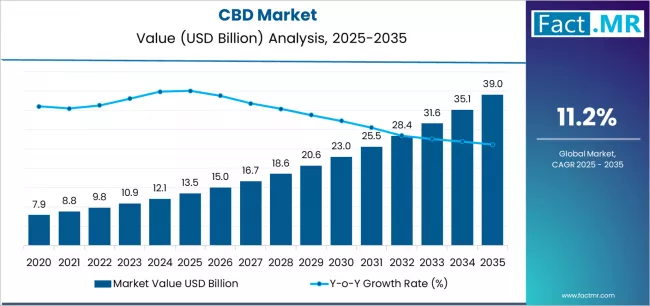
Between 2025 and 2030, the CBD market is projected to expand from USD 13.5 billion to USD 22.5 billion, resulting in a value increase of USD 9.0 billion, which represents 35.3% of the total forecast growth for the decade. This phase of development will be shaped by increasing mainstream retail adoption, growing regulatory clarity and acceptance, and expanding product categories including beverages, cosmetics, and pet products. CBD companies and retailers are expanding their market capabilities to address the growing demand for wellness and therapeutic CBD solutions.
CBD Market Key Takeaways
| Metric | Value |
|---|---|
| Estimated Value in (2025E) | USD 13.5 billion |
| Forecast Value in (2035F) | USD 39 billion |
| Forecast CAGR (2025 to 2035) | 11.2% |
From 2030 to 2035, the market is forecast to grow from USD 22.5 billion to USD 39 billion, adding another USD 16.5 billion, which constitutes 64.7% of the overall ten-year expansion. This period is expected to be characterized by the expansion of international markets, development of standardized quality regulations, and growth of CBD integration into mainstream consumer products and healthcare applications. The growing adoption of evidence-based CBD research and clinical validation will drive demand for CBD products with enhanced therapeutic credibility and regulatory compliance.
Between 2020 and 2025, the CBD market experienced explosive growth, driven by increasing legalization across multiple jurisdictions and growing recognition of CBD as a wellness ingredient with therapeutic potential for anxiety, pain management, and sleep disorders. The market developed as consumers and healthcare practitioners recognized the potential for CBD to provide natural wellness support, address chronic conditions, and offer alternative therapeutic options while supporting lifestyle enhancement and health optimization goals.
Why is the CBD Market Growing?
Market expansion is being supported by the increasing consumer interest in natural wellness solutions driven by health consciousness and alternative therapy preferences, alongside the corresponding need for effective and safe CBD products that can address stress, anxiety, pain, and sleep issues while providing natural alternatives to pharmaceutical interventions across various consumer demographics and wellness applications. Modern CBD companies and wellness retailers are increasingly focused on implementing CBD solutions that can support holistic health, provide therapeutic benefits, and offer natural wellness alternatives while maintaining quality standards and regulatory compliance.
The growing emphasis on mental health and wellness optimization is driving demand for CBD products that can support stress management, enhance sleep quality, and provide comprehensive wellness benefits. Consumer preference for products that combine therapeutic potential with natural positioning and safety profiles is creating opportunities for innovative CBD implementations. The rising influence of preventive healthcare and self-care trends is also contributing to increased adoption of CBD products that can provide superior wellness support without the side effects associated with traditional pharmaceutical approaches.
Segmental Analysis
The market is segmented by product type, distribution channel, and spectrum type. By product type, the market is divided into tinctures/oils, topicals, and gummies/edibles. Based on distribution channel, the market is categorized into dispensary/licensed retail, online, and mass retail channels. By spectrum type, the market is segmented into broad spectrum, isolate, and full spectrum products.
By Product Type, the Tinctures/Oils Segment Leads the Market
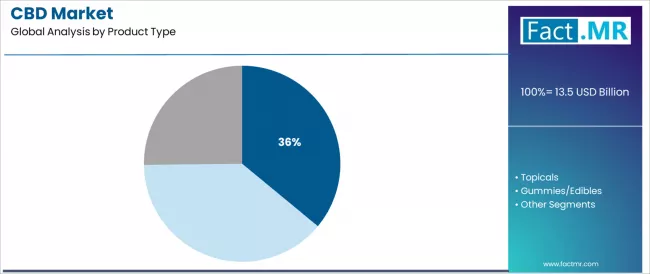
The tinctures/oils segment is projected to maintain its leading position in the CBD market in 2025 with a 36% market share, reaffirming its role as the preferred product format for CBD consumption due to versatility, precise dosing, and proven effectiveness. CBD manufacturers and consumers increasingly utilize tincture and oil formats for their flexible dosing capabilities, sublingual absorption benefits, and proven effectiveness in delivering consistent CBD effects while maintaining product stability and consumer compliance. Tincture/oil format's proven versatility and consumer acceptance directly address market requirements for customizable CBD consumption and established wellness routines across diverse consumer segments and therapeutic applications.
This product segment forms the foundation of CBD consumption, as it represents the format with the greatest contribution to therapeutic flexibility and established consumer recognition across multiple wellness applications and dosing preferences. CBD industry investments in extraction and formulation technologies continue to strengthen adoption among manufacturers and consumers. With wellness applications requiring precise and flexible dosing, tinctures and oils align with both therapeutic objectives and consumer control requirements, making them the central component of comprehensive CBD wellness strategies.
By Distribution Channel, the Dispensary/Licensed Retail Segment Dominates Market Access
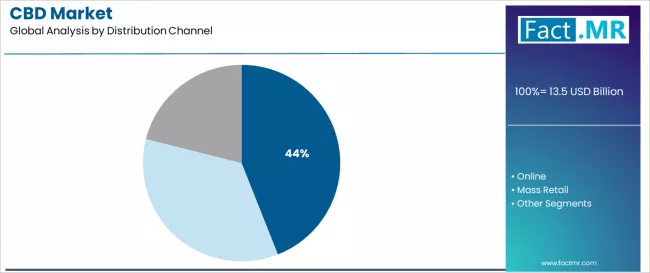
The dispensary/licensed retail distribution channel segment is projected to represent the largest share of CBD demand in 2025 with a 44% market share, underscoring its critical role as the primary avenue for CBD sales in regulated markets with established compliance and consumer education capabilities. Licensed retailers provide product expertise, regulatory compliance, and consumer education that are essential for responsible CBD consumption and market development. Positioned as trusted channels for CBD access, dispensaries and licensed retailers offer both regulatory compliance advantages and consumer confidence benefits.
The segment is supported by continuous expansion of legal frameworks and the growing availability of specialized CBD retail formats that enable superior customer service with enhanced product selection and educational support. Additionally, licensed retailers are investing in comprehensive staff training programs to support increasingly sophisticated CBD product offerings and consumer education requirements. As regulatory frameworks mature and consumer confidence grows, the dispensary/licensed retail channel will continue to dominate the market while supporting responsible consumption practices and consumer education optimization.
What are the Drivers, Restraints, and Key Trends of the CBD Market?
The CBD market is advancing rapidly due to increasing legalization and regulatory acceptance driven by growing recognition of therapeutic potential and economic benefits, alongside expanding consumer awareness of CBD wellness applications that provide natural alternatives for anxiety, pain management, sleep disorders, and stress relief across diverse demographic groups and lifestyle applications. However, the market faces challenges, including complex and evolving regulatory frameworks, quality standardization issues across suppliers, and consumer education needs regarding proper usage and effects. Innovation in extraction technologies and product development continues to influence market quality and accessibility patterns.
Expansion of Mainstream Retail and Consumer Acceptance
The growing acceptance of CBD in mainstream retail environments is driving market expansion through increased product availability, enhanced consumer education, and normalized purchasing experiences that reduce stigma and increase accessibility for mainstream consumers. Major retailers require CBD products that meet stringent quality standards, regulatory compliance, and consumer safety requirements while providing reliable supply chains and brand credibility. Retail companies are increasingly recognizing the competitive advantages of CBD category development for consumer wellness positioning and market differentiation, creating opportunities for premium CBD products designed for mainstream consumer applications and retail environments.
Integration of Quality Standardization and Third-Party Testing
Modern CBD manufacturers are incorporating comprehensive quality control systems and third-party testing protocols to enhance product reliability, ensure potency accuracy, and support consumer confidence through COA transparency, contamination screening, and consistency verification. Leading companies are developing ISO-compliant manufacturing processes, implementing blockchain traceability systems, and advancing quality assurance technologies that demonstrate product integrity while building consumer trust and regulatory compliance. These quality improvements enable market credibility while creating opportunities for premium positioning, healthcare provider acceptance, and institutional market development.
Development of Innovative Product Categories and Applications
The expansion of CBD applications beyond traditional formats is driving innovation in beverages, cosmetics, pet products, and functional foods that integrate CBD into everyday consumer products and lifestyle applications. These innovative product developments require specialized formulation expertise and regulatory navigation that create differentiated market segments with unique value propositions. Manufacturers are investing in product innovation and category development to serve emerging consumer needs while supporting market expansion beyond traditional wellness applications into mainstream consumer goods and lifestyle products.
Analysis of the CBD Market by Key Countries
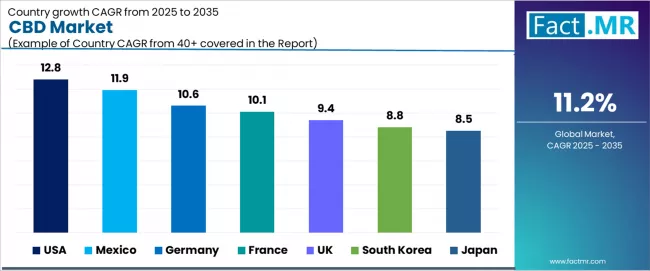
| Country | CAGR (2025-2035) |
|---|---|
| USA | 12.8% |
| Mexico | 11.9% |
| Germany | 10.6% |
| France | 10.1% |
| UK | 9.4% |
| South Korea | 8.8% |
| Japan | 8.5% |
The CBD market is experiencing exceptional growth globally, with the USA leading at a 12.8% CAGR through 2035, driven by extensive state-level legalization, mature regulatory frameworks, and strong consumer acceptance supporting comprehensive CBD market development. Mexico follows at 11.9%, supported by progressive cannabis reform, expanding medical applications, and growing wellness market acceptance. Germany shows growth at 10.6%, emphasizing medical cannabis leadership, pharmaceutical-grade standards, and comprehensive regulatory frameworks. France demonstrates 10.1% growth, supported by evolving regulations, wellness market development, and premium product positioning. The UK records 9.4%, focusing on regulatory clarity, wellness applications, and premium market development. South Korea exhibits 8.8% growth, emphasizing medical research and controlled market development. Japan shows 8.5% growth, supported by pharmaceutical research and quality standards.
USA Leads Global Market Growth with Regulatory Leadership
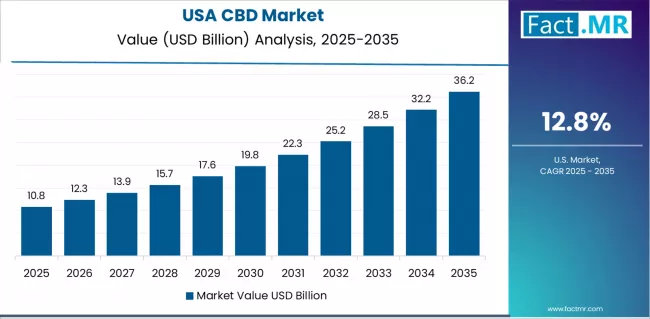
Revenue from CBD in the USA is projected to exhibit exceptional growth with a CAGR of 12.8% through 2035, driven by extensive state-level legalization and mature regulatory frameworks supporting comprehensive CBD market development among licensed operators, wellness companies, and mainstream retailers. The country's established cannabis industry infrastructure and consumer acceptance are creating substantial demand for CBD solutions across diverse product categories and distribution channels. Major CBD companies and mainstream retailers are establishing comprehensive operations to serve both established markets and emerging opportunities.
- Strong state-level legalization and regulatory maturity are driving demand for CBD products throughout licensed dispensaries, wellness retailers, and mainstream channels across legalized states, urban markets, and health-conscious consumer segments.
- Growing consumer acceptance and mainstream retail integration are supporting the rapid expansion of CBD applications among companies seeking wellness market positioning, therapeutic differentiation, and consumer health solutions for diverse demographic groups and wellness applications.
Mexico Demonstrates Strong Market Potential with Cannabis Reform
Revenue from CBD in Mexico is expanding at a CAGR of 11.9%, supported by the country's progressive cannabis reform initiatives, expanding medical cannabis programs, and growing wellness market acceptance driving CBD adoption for both medical and wellness applications. The country's evolving regulatory landscape and increasing healthcare integration are driving demand for CBD solutions throughout medical and wellness sectors. Leading wellness companies and medical cannabis operators are establishing comprehensive capabilities to address growing therapeutic and wellness demand.
- Progressive cannabis reform and expanding medical applications are creating opportunities for CBD adoption across medical cannabis facilities, wellness centers, and healthcare providers in major urban markets and progressive regions.
- Growing wellness market acceptance and healthcare integration are driving adoption of CBD products among consumers and practitioners seeking natural therapeutic alternatives, pain management solutions, and wellness enhancement for diverse health and lifestyle applications.
Germany Demonstrates Medical Excellence with Pharmaceutical Standards
Revenue from CBD in Germany is expanding at a CAGR of 10.6%, driven by the country's medical cannabis leadership, pharmaceutical-grade manufacturing standards, and comprehensive regulatory framework supporting high-quality CBD development. Germany's healthcare system integration and quality standards are driving demand for medical-grade CBD solutions. Leading pharmaceutical companies and medical cannabis operators are establishing comprehensive quality programs for therapeutic CBD applications.
- Advanced medical cannabis framework and pharmaceutical standards are creating demand for premium CBD products among healthcare providers, medical cannabis facilities, and quality-focused wellness companies seeking therapeutic effectiveness and regulatory compliance.
- Strong healthcare system integration and quality consciousness are supporting the adoption of pharmaceutical-grade CBD across medical facilities, specialized pharmacies, and healthcare-integrated wellness programs throughout major medical and urban regions.
France Focuses on Premium Wellness and Regulatory Evolution
Revenue from CBD in France is expanding at a CAGR of 10.1%, driven by the country's evolving cannabis regulations, premium wellness market development, and sophisticated approach to CBD integration supporting high-quality CBD adoption. France's wellness sophistication and premium product culture are supporting investment in CBD market development. Major wellness companies and premium retailers are establishing comprehensive programs for French CBD market development.
- Advanced wellness culture and premium product focus are creating demand for high-quality CBD products throughout premium wellness retailers, specialty stores, and sophisticated consumer channels serving quality-conscious wellness segments.
- Strong regulatory evolution and wellness market sophistication are driving the adoption of premium CBD products across wellness-focused retail channels, premium health stores, and sophisticated consumer applications throughout major metropolitan and wellness regions.
UK Shows Market Leadership with Wellness Integration
Revenue from CBD in the UK is expanding at a CAGR of 9.4%, supported by the country's regulatory clarity initiatives, wellness market leadership, and comprehensive approach to CBD wellness applications supporting market development across diverse consumer segments. The UK's wellness market maturity and regulatory progress are driving demand for compliant CBD solutions. Leading wellness companies and retailers are investing in CBD market development and regulatory compliance for consumer wellness applications.
- Advanced wellness market development and regulatory clarity are creating opportunities for CBD products throughout wellness retailers, health stores, and premium consumer channels serving wellness-focused market segments.
- Strong wellness culture and consumer health focus are driving the adoption of CBD wellness products across health-conscious retail channels, wellness-oriented applications, and consumer health solutions targeting natural wellness consumers.
South Korea Demonstrates Research Leadership with Medical Development
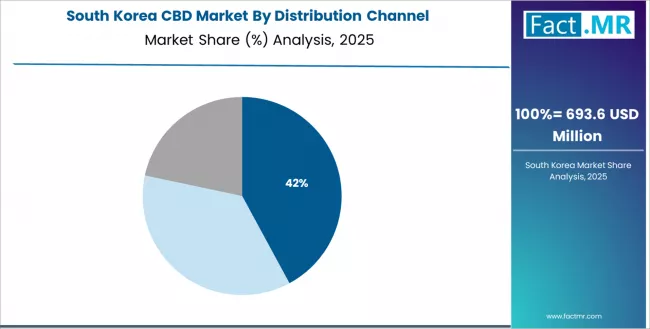
Revenue from CBD in South Korea is expanding at a CAGR of 8.8%, supported by the country's medical cannabis research initiatives, pharmaceutical development focus, and controlled market development supporting research-based CBD applications. The nation's healthcare innovation and research capabilities are driving demand for research-grade CBD solutions. Leading pharmaceutical and research companies are investing extensively in CBD research and controlled market development.
- Advanced medical research capabilities and pharmaceutical development focus are creating demand for research-grade CBD products throughout pharmaceutical companies, research institutions, and medical development facilities.
- Strong healthcare innovation and controlled market approach are supporting the adoption of CBD research applications designed for medical development, pharmaceutical research, and controlled therapeutic applications across healthcare and research sectors.
Japan Shows Premium Focus with Pharmaceutical Research
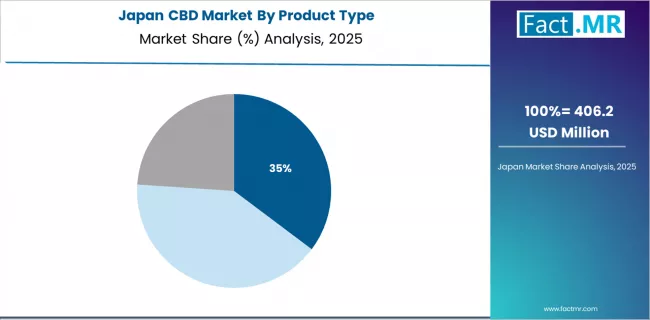
Revenue from CBD in Japan is expanding at a CAGR of 8.5%, supported by the country's pharmaceutical research excellence, quality standards, and controlled approach to CBD research supporting high-quality pharmaceutical CBD development. Japan's pharmaceutical sophistication and quality consciousness are driving demand for pharmaceutical-grade CBD products. Leading pharmaceutical companies are investing in specialized capabilities for CBD research and pharmaceutical applications.
- Advanced pharmaceutical research and quality standards are creating opportunities for pharmaceutical-grade CBD products throughout pharmaceutical companies, research institutions, and medical development centers serving pharmaceutical research applications.
- Strong quality consciousness and pharmaceutical excellence are driving adoption of premium CBD research products meeting Japanese standards for pharmaceutical development, research quality, and comprehensive medical applications across pharmaceutical and healthcare sectors.
Europe Market Split by Country
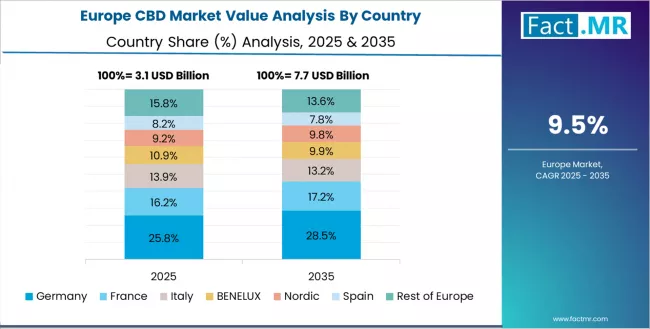
The CBD market in Europe is projected to grow from USD 3.8 billion in 2025 to USD 10.2 billion by 2035, registering a CAGR of 10.4% over the forecast period. Germany is expected to maintain leadership with a 31.6% market share in 2025, moderating to 31.2% by 2035, supported by medical cannabis leadership, pharmaceutical standards, and comprehensive regulatory frameworks.
France follows with 23.7% in 2025, projected to reach 24.1% by 2035, driven by evolving regulations, premium wellness market development, and sophisticated consumer applications. The United Kingdom holds 21.1% in 2025, expected to reach 21.4% by 2035 due to regulatory clarity initiatives and wellness market leadership. Italy commands 13.2% in 2025, rising to 13.3% by 2035, while Spain accounts for 7.1% in 2025, reaching 7.2% by 2035. The Rest of Europe region is anticipated to hold 3.3% in 2025 and 2.8% by 2035, reflecting steady CBD market development in progressive European countries and emerging cannabis markets with evolving regulatory frameworks.
Competitive Landscape of the CBD Market
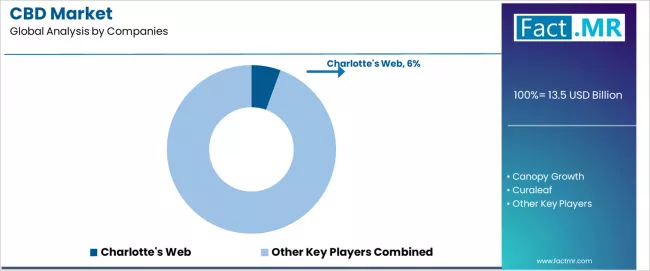
The CBD market is characterized by competition among established cannabis companies, wellness brands, and mainstream consumer goods companies. Companies are investing in extraction technology development, quality assurance systems, regulatory compliance programs, and brand development to deliver safe, effective, and legally compliant CBD solutions. Innovation in product formulation, delivery systems, and therapeutic applications is central to strengthening market position and competitive advantage.
Charlotte's Web leads the market with a 5.6% share, offering comprehensive CBD solutions with focus on hemp-derived products, quality assurance, and consumer education across diverse wellness and therapeutic applications. The company continues investing in cultivation, extraction capabilities, and brand development while expanding retail distribution and product innovation programs. Canopy Growth provides extensive cannabis and CBD portfolio with global reach and pharmaceutical development. Curaleaf offers comprehensive cannabis operations with CBD focus. CV Sciences specializes in hemp-derived CBD products and wellness applications. Green Roads focuses on pharmacist-formulated CBD products. Medterra emphasizes broad spectrum CBD and mainstream retail positioning.
Key Players in the CBD Market
- Charlotte's Web
- Canopy Growth
- Curaleaf
- CV Sciences
- Green Roads
- Medterra
- Aurora Cannabis
- Tilray Brands
- Endoca
- Elixinol
Scope of the Report
| Items | Values |
|---|---|
| Quantitative Units (2025) | USD 13.5 billion |
| Product Type | Tinctures/Oils, Topicals, Gummies/Edibles |
| Distribution Channel | Dispensary/Licensed Retail, Online, Mass Retail |
| Spectrum Type | Broad Spectrum, Isolate, Full Spectrum |
| Regions Covered | North America, Europe, Asia-Pacific, Latin America, Middle East & Africa |
| Countries Covered | USA, Mexico, Germany, France, UK, Japan, South Korea, and 40+ countries |
| Key Companies Profiled | Charlotte's Web, Canopy Growth, Curaleaf, CV Sciences, Green Roads, Medterra |
| Additional Attributes | Dollar sales by product type and distribution channel, regional demand trends, competitive landscape, regulatory development tracking, quality standardization advancement, therapeutic research progress, and consumer education optimization |
CBD Market by Segments
-
Product Type :
- Tinctures/Oils
- Topicals
- Gummies/Edibles
-
Distribution Channel :
- Dispensary/Licensed Retail
- Online
- Mass Retail
-
Spectrum Type :
- Broad Spectrum
- Isolate
- Full Spectrum
-
Region :
-
North America
- United States
- Canada
- Mexico
-
Europe
- Germany
- United Kingdom
- France
- Italy
- Spain
- Netherlands
- Rest of Europe
-
Asia-Pacific
- Japan
- South Korea
- China
- India
- Australia
- Rest of Asia-Pacific
-
Latin America
- Brazil
- Argentina
- Rest of Latin America
-
Middle East & Africa
- Kingdom of Saudi Arabia
- South Africa
- Rest of Middle East & Africa
-
Table of Content
- Executive Summary
- Global Market Outlook
- Demand to side Trends
- Supply to side Trends
- Technology Roadmap Analysis
- Analysis and Recommendations
- Market Overview
- Market Coverage / Taxonomy
- Market Definition / Scope / Limitations
- Market Background
- Market Dynamics
- Drivers
- Restraints
- Opportunity
- Trends
- Scenario Forecast
- Demand in Optimistic Scenario
- Demand in Likely Scenario
- Demand in Conservative Scenario
- Opportunity Map Analysis
- Product Life Cycle Analysis
- Supply Chain Analysis
- Investment Feasibility Matrix
- Value Chain Analysis
- PESTLE and Porter’s Analysis
- Regulatory Landscape
- Regional Parent Market Outlook
- Production and Consumption Statistics
- Import and Export Statistics
- Market Dynamics
- Global Market Analysis 2020 to 2024 and Forecast, 2025 to 2035
- Historical Market Size Value (USD Million) Analysis, 2020 to 2024
- Current and Future Market Size Value (USD Million) Projections, 2025 to 2035
- Y to o to Y Growth Trend Analysis
- Absolute $ Opportunity Analysis
- Global Market Pricing Analysis 2020 to 2024 and Forecast 2025 to 2035
- Global Market Analysis 2020 to 2024 and Forecast 2025 to 2035, By Product Type
- Introduction / Key Findings
- Historical Market Size Value (USD Million) Analysis By Product Type , 2020 to 2024
- Current and Future Market Size Value (USD Million) Analysis and Forecast By Product Type , 2025 to 2035
- Tinctures/Oils
- Topicals
- Gummies/Edibles
- Y to o to Y Growth Trend Analysis By Product Type , 2020 to 2024
- Absolute $ Opportunity Analysis By Product Type , 2025 to 2035
- Global Market Analysis 2020 to 2024 and Forecast 2025 to 2035, By Distribution Channel
- Introduction / Key Findings
- Historical Market Size Value (USD Million) Analysis By Distribution Channel, 2020 to 2024
- Current and Future Market Size Value (USD Million) Analysis and Forecast By Distribution Channel, 2025 to 2035
- Dispensary/Licensed Retail
- Online
- Mass Retail
- Y to o to Y Growth Trend Analysis By Distribution Channel, 2020 to 2024
- Absolute $ Opportunity Analysis By Distribution Channel, 2025 to 2035
- Global Market Analysis 2020 to 2024 and Forecast 2025 to 2035, By Region
- Introduction
- Historical Market Size Value (USD Million) Analysis By Region, 2020 to 2024
- Current Market Size Value (USD Million) Analysis and Forecast By Region, 2025 to 2035
- North America
- Latin America
- Western Europe
- Eastern Europe
- East Asia
- South Asia and Pacific
- Middle East & Africa
- Market Attractiveness Analysis By Region
- North America Market Analysis 2020 to 2024 and Forecast 2025 to 2035, By Country
- Historical Market Size Value (USD Million) Trend Analysis By Market Taxonomy, 2020 to 2024
- Market Size Value (USD Million) Forecast By Market Taxonomy, 2025 to 2035
- By Country
- USA
- Canada
- Mexico
- By Product Type
- By Distribution Channel
- By Country
- Market Attractiveness Analysis
- By Country
- By Product Type
- By Distribution Channel
- Key Takeaways
- Latin America Market Analysis 2020 to 2024 and Forecast 2025 to 2035, By Country
- Historical Market Size Value (USD Million) Trend Analysis By Market Taxonomy, 2020 to 2024
- Market Size Value (USD Million) Forecast By Market Taxonomy, 2025 to 2035
- By Country
- Brazil
- Chile
- Rest of Latin America
- By Product Type
- By Distribution Channel
- By Country
- Market Attractiveness Analysis
- By Country
- By Product Type
- By Distribution Channel
- Key Takeaways
- Western Europe Market Analysis 2020 to 2024 and Forecast 2025 to 2035, By Country
- Historical Market Size Value (USD Million) Trend Analysis By Market Taxonomy, 2020 to 2024
- Market Size Value (USD Million) Forecast By Market Taxonomy, 2025 to 2035
- By Country
- Germany
- UK
- Italy
- Spain
- France
- Nordic
- BENELUX
- Rest of Western Europe
- By Product Type
- By Distribution Channel
- By Country
- Market Attractiveness Analysis
- By Country
- By Product Type
- By Distribution Channel
- Key Takeaways
- Eastern Europe Market Analysis 2020 to 2024 and Forecast 2025 to 2035, By Country
- Historical Market Size Value (USD Million) Trend Analysis By Market Taxonomy, 2020 to 2024
- Market Size Value (USD Million) Forecast By Market Taxonomy, 2025 to 2035
- By Country
- Russia
- Poland
- Hungary
- Balkan & Baltic
- Rest of Eastern Europe
- By Product Type
- By Distribution Channel
- By Country
- Market Attractiveness Analysis
- By Country
- By Product Type
- By Distribution Channel
- Key Takeaways
- East Asia Market Analysis 2020 to 2024 and Forecast 2025 to 2035, By Country
- Historical Market Size Value (USD Million) Trend Analysis By Market Taxonomy, 2020 to 2024
- Market Size Value (USD Million) Forecast By Market Taxonomy, 2025 to 2035
- By Country
- China
- Japan
- South Korea
- By Product Type
- By Distribution Channel
- By Country
- Market Attractiveness Analysis
- By Country
- By Product Type
- By Distribution Channel
- Key Takeaways
- South Asia and Pacific Market Analysis 2020 to 2024 and Forecast 2025 to 2035, By Country
- Historical Market Size Value (USD Million) Trend Analysis By Market Taxonomy, 2020 to 2024
- Market Size Value (USD Million) Forecast By Market Taxonomy, 2025 to 2035
- By Country
- India
- ASEAN
- Australia & New Zealand
- Rest of South Asia and Pacific
- By Product Type
- By Distribution Channel
- By Country
- Market Attractiveness Analysis
- By Country
- By Product Type
- By Distribution Channel
- Key Takeaways
- Middle East & Africa Market Analysis 2020 to 2024 and Forecast 2025 to 2035, By Country
- Historical Market Size Value (USD Million) Trend Analysis By Market Taxonomy, 2020 to 2024
- Market Size Value (USD Million) Forecast By Market Taxonomy, 2025 to 2035
- By Country
- Kingdom of Saudi Arabia
- Other GCC Countries
- Turkiye
- South Africa
- Other African Union
- Rest of Middle East & Africa
- By Product Type
- By Distribution Channel
- By Country
- Market Attractiveness Analysis
- By Country
- By Product Type
- By Distribution Channel
- Key Takeaways
- Key Countries Market Analysis
- USA
- Pricing Analysis
- Market Share Analysis, 2024
- By Product Type
- By Distribution Channel
- Canada
- Pricing Analysis
- Market Share Analysis, 2024
- By Product Type
- By Distribution Channel
- Mexico
- Pricing Analysis
- Market Share Analysis, 2024
- By Product Type
- By Distribution Channel
- Brazil
- Pricing Analysis
- Market Share Analysis, 2024
- By Product Type
- By Distribution Channel
- Chile
- Pricing Analysis
- Market Share Analysis, 2024
- By Product Type
- By Distribution Channel
- Germany
- Pricing Analysis
- Market Share Analysis, 2024
- By Product Type
- By Distribution Channel
- UK
- Pricing Analysis
- Market Share Analysis, 2024
- By Product Type
- By Distribution Channel
- Italy
- Pricing Analysis
- Market Share Analysis, 2024
- By Product Type
- By Distribution Channel
- Spain
- Pricing Analysis
- Market Share Analysis, 2024
- By Product Type
- By Distribution Channel
- France
- Pricing Analysis
- Market Share Analysis, 2024
- By Product Type
- By Distribution Channel
- India
- Pricing Analysis
- Market Share Analysis, 2024
- By Product Type
- By Distribution Channel
- ASEAN
- Pricing Analysis
- Market Share Analysis, 2024
- By Product Type
- By Distribution Channel
- Australia & New Zealand
- Pricing Analysis
- Market Share Analysis, 2024
- By Product Type
- By Distribution Channel
- China
- Pricing Analysis
- Market Share Analysis, 2024
- By Product Type
- By Distribution Channel
- Japan
- Pricing Analysis
- Market Share Analysis, 2024
- By Product Type
- By Distribution Channel
- South Korea
- Pricing Analysis
- Market Share Analysis, 2024
- By Product Type
- By Distribution Channel
- Russia
- Pricing Analysis
- Market Share Analysis, 2024
- By Product Type
- By Distribution Channel
- Poland
- Pricing Analysis
- Market Share Analysis, 2024
- By Product Type
- By Distribution Channel
- Hungary
- Pricing Analysis
- Market Share Analysis, 2024
- By Product Type
- By Distribution Channel
- Kingdom of Saudi Arabia
- Pricing Analysis
- Market Share Analysis, 2024
- By Product Type
- By Distribution Channel
- Turkiye
- Pricing Analysis
- Market Share Analysis, 2024
- By Product Type
- By Distribution Channel
- South Africa
- Pricing Analysis
- Market Share Analysis, 2024
- By Product Type
- By Distribution Channel
- USA
- Market Structure Analysis
- Competition Dashboard
- Competition Benchmarking
- Market Share Analysis of Top Players
- By Regional
- By Product Type
- By Distribution Channel
- Competition Analysis
- Competition Deep Dive
- Charlotte's Web
- Overview
- Product Portfolio
- Profitability by Market Segments (Product/Age /Sales Channel/Region)
- Sales Footprint
- Strategy Overview
- Marketing Strategy
- Product Strategy
- Channel Strategy
- Canopy Growth
- Curaleaf
- CV Sciences
- Green Roads
- Medterra
- Aurora Cannabis
- Tilray Brands
- Endoca
- Elixinol
- Charlotte's Web
- Competition Deep Dive
- Assumptions & Acronyms Used
- Research Methodology
List Of Table
- Table 1: Global Market Value (USD Million) Forecast by Region, 2020 to 2035
- Table 2: Global Market Value (USD Million) Forecast by Product Type , 2020 to 2035
- Table 3: Global Market Value (USD Million) Forecast by Distribution Channel, 2020 to 2035
- Table 4: North America Market Value (USD Million) Forecast by Country, 2020 to 2035
- Table 5: North America Market Value (USD Million) Forecast by Product Type , 2020 to 2035
- Table 6: North America Market Value (USD Million) Forecast by Distribution Channel, 2020 to 2035
- Table 7: Latin America Market Value (USD Million) Forecast by Country, 2020 to 2035
- Table 8: Latin America Market Value (USD Million) Forecast by Product Type , 2020 to 2035
- Table 9: Latin America Market Value (USD Million) Forecast by Distribution Channel, 2020 to 2035
- Table 10: Western Europe Market Value (USD Million) Forecast by Country, 2020 to 2035
- Table 11: Western Europe Market Value (USD Million) Forecast by Product Type , 2020 to 2035
- Table 12: Western Europe Market Value (USD Million) Forecast by Distribution Channel, 2020 to 2035
- Table 13: Eastern Europe Market Value (USD Million) Forecast by Country, 2020 to 2035
- Table 14: Eastern Europe Market Value (USD Million) Forecast by Product Type , 2020 to 2035
- Table 15: Eastern Europe Market Value (USD Million) Forecast by Distribution Channel, 2020 to 2035
- Table 16: East Asia Market Value (USD Million) Forecast by Country, 2020 to 2035
- Table 17: East Asia Market Value (USD Million) Forecast by Product Type , 2020 to 2035
- Table 18: East Asia Market Value (USD Million) Forecast by Distribution Channel, 2020 to 2035
- Table 19: South Asia and Pacific Market Value (USD Million) Forecast by Country, 2020 to 2035
- Table 20: South Asia and Pacific Market Value (USD Million) Forecast by Product Type , 2020 to 2035
- Table 21: South Asia and Pacific Market Value (USD Million) Forecast by Distribution Channel, 2020 to 2035
- Table 22: Middle East & Africa Market Value (USD Million) Forecast by Country, 2020 to 2035
- Table 23: Middle East & Africa Market Value (USD Million) Forecast by Product Type , 2020 to 2035
- Table 24: Middle East & Africa Market Value (USD Million) Forecast by Distribution Channel, 2020 to 2035
List Of Figures
- Figure 1: Global Market Pricing Analysis
- Figure 2: Global Market Value (USD Million) Forecast 2020-2035
- Figure 3: Global Market Value Share and BPS Analysis by Product Type , 2025 and 2035
- Figure 4: Global Market Y to o to Y Growth Comparison by Product Type , 2025-2035
- Figure 5: Global Market Attractiveness Analysis by Product Type
- Figure 6: Global Market Value Share and BPS Analysis by Distribution Channel, 2025 and 2035
- Figure 7: Global Market Y to o to Y Growth Comparison by Distribution Channel, 2025-2035
- Figure 8: Global Market Attractiveness Analysis by Distribution Channel
- Figure 9: Global Market Value (USD Million) Share and BPS Analysis by Region, 2025 and 2035
- Figure 10: Global Market Y to o to Y Growth Comparison by Region, 2025-2035
- Figure 11: Global Market Attractiveness Analysis by Region
- Figure 12: North America Market Incremental Dollar Opportunity, 2025-2035
- Figure 13: Latin America Market Incremental Dollar Opportunity, 2025-2035
- Figure 14: Western Europe Market Incremental Dollar Opportunity, 2025-2035
- Figure 15: Eastern Europe Market Incremental Dollar Opportunity, 2025-2035
- Figure 16: East Asia Market Incremental Dollar Opportunity, 2025-2035
- Figure 17: South Asia and Pacific Market Incremental Dollar Opportunity, 2025-2035
- Figure 18: Middle East & Africa Market Incremental Dollar Opportunity, 2025-2035
- Figure 19: North America Market Value Share and BPS Analysis by Country, 2025 and 2035
- Figure 20: North America Market Value Share and BPS Analysis by Product Type , 2025 and 2035
- Figure 21: North America Market Y to o to Y Growth Comparison by Product Type , 2025-2035
- Figure 22: North America Market Attractiveness Analysis by Product Type
- Figure 23: North America Market Value Share and BPS Analysis by Distribution Channel, 2025 and 2035
- Figure 24: North America Market Y to o to Y Growth Comparison by Distribution Channel, 2025-2035
- Figure 25: North America Market Attractiveness Analysis by Distribution Channel
- Figure 26: Latin America Market Value Share and BPS Analysis by Country, 2025 and 2035
- Figure 27: Latin America Market Value Share and BPS Analysis by Product Type , 2025 and 2035
- Figure 28: Latin America Market Y to o to Y Growth Comparison by Product Type , 2025-2035
- Figure 29: Latin America Market Attractiveness Analysis by Product Type
- Figure 30: Latin America Market Value Share and BPS Analysis by Distribution Channel, 2025 and 2035
- Figure 31: Latin America Market Y to o to Y Growth Comparison by Distribution Channel, 2025-2035
- Figure 32: Latin America Market Attractiveness Analysis by Distribution Channel
- Figure 33: Western Europe Market Value Share and BPS Analysis by Country, 2025 and 2035
- Figure 34: Western Europe Market Value Share and BPS Analysis by Product Type , 2025 and 2035
- Figure 35: Western Europe Market Y to o to Y Growth Comparison by Product Type , 2025-2035
- Figure 36: Western Europe Market Attractiveness Analysis by Product Type
- Figure 37: Western Europe Market Value Share and BPS Analysis by Distribution Channel, 2025 and 2035
- Figure 38: Western Europe Market Y to o to Y Growth Comparison by Distribution Channel, 2025-2035
- Figure 39: Western Europe Market Attractiveness Analysis by Distribution Channel
- Figure 40: Eastern Europe Market Value Share and BPS Analysis by Country, 2025 and 2035
- Figure 41: Eastern Europe Market Value Share and BPS Analysis by Product Type , 2025 and 2035
- Figure 42: Eastern Europe Market Y to o to Y Growth Comparison by Product Type , 2025-2035
- Figure 43: Eastern Europe Market Attractiveness Analysis by Product Type
- Figure 44: Eastern Europe Market Value Share and BPS Analysis by Distribution Channel, 2025 and 2035
- Figure 45: Eastern Europe Market Y to o to Y Growth Comparison by Distribution Channel, 2025-2035
- Figure 46: Eastern Europe Market Attractiveness Analysis by Distribution Channel
- Figure 47: East Asia Market Value Share and BPS Analysis by Country, 2025 and 2035
- Figure 48: East Asia Market Value Share and BPS Analysis by Product Type , 2025 and 2035
- Figure 49: East Asia Market Y to o to Y Growth Comparison by Product Type , 2025-2035
- Figure 50: East Asia Market Attractiveness Analysis by Product Type
- Figure 51: East Asia Market Value Share and BPS Analysis by Distribution Channel, 2025 and 2035
- Figure 52: East Asia Market Y to o to Y Growth Comparison by Distribution Channel, 2025-2035
- Figure 53: East Asia Market Attractiveness Analysis by Distribution Channel
- Figure 54: South Asia and Pacific Market Value Share and BPS Analysis by Country, 2025 and 2035
- Figure 55: South Asia and Pacific Market Value Share and BPS Analysis by Product Type , 2025 and 2035
- Figure 56: South Asia and Pacific Market Y to o to Y Growth Comparison by Product Type , 2025-2035
- Figure 57: South Asia and Pacific Market Attractiveness Analysis by Product Type
- Figure 58: South Asia and Pacific Market Value Share and BPS Analysis by Distribution Channel, 2025 and 2035
- Figure 59: South Asia and Pacific Market Y to o to Y Growth Comparison by Distribution Channel, 2025-2035
- Figure 60: South Asia and Pacific Market Attractiveness Analysis by Distribution Channel
- Figure 61: Middle East & Africa Market Value Share and BPS Analysis by Country, 2025 and 2035
- Figure 62: Middle East & Africa Market Value Share and BPS Analysis by Product Type , 2025 and 2035
- Figure 63: Middle East & Africa Market Y to o to Y Growth Comparison by Product Type , 2025-2035
- Figure 64: Middle East & Africa Market Attractiveness Analysis by Product Type
- Figure 65: Middle East & Africa Market Value Share and BPS Analysis by Distribution Channel, 2025 and 2035
- Figure 66: Middle East & Africa Market Y to o to Y Growth Comparison by Distribution Channel, 2025-2035
- Figure 67: Middle East & Africa Market Attractiveness Analysis by Distribution Channel
- Figure 68: Global Market - Tier Structure Analysis
- Figure 69: Global Market - Company Share Analysis
- FAQs -
How big is the cbd market in 2025?
The global cbd market is estimated to be valued at USD 13.5 billion in 2025.
What will be the size of cbd market in 2035?
The market size for the cbd market is projected to reach USD 39.0 billion by 2035.
How much will be the cbd market growth between 2025 and 2035?
The cbd market is expected to grow at a 11.2% CAGR between 2025 and 2035.
What are the key product types in the cbd market?
The key product types in cbd market are tinctures/oils, topicals and gummies/edibles.
Which distribution channel segment to contribute significant share in the cbd market in 2025?
In terms of distribution channel, dispensary/licensed retail segment to command 44.0% share in the cbd market in 2025.